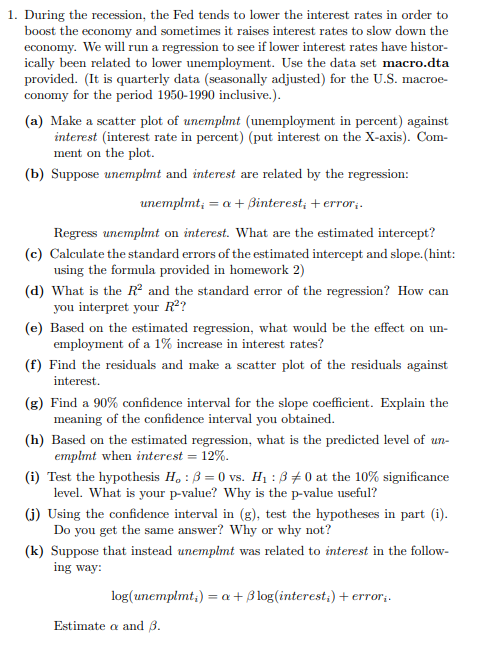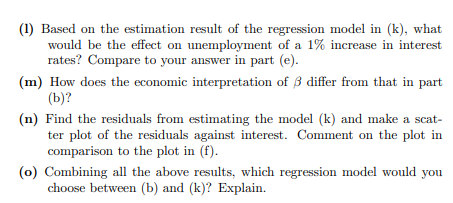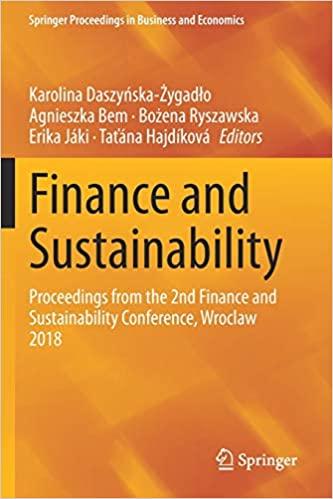

1. During the recession, the Fed tends to lower the interest rates in order to boost the economy and sometimes it raises interest rates to slow down the economy. We will run a regression to see if lower interest rates have histor- ically been related to lower unemployment. Use the data set macro.dta provided. (It is quarterly data (seasonally adjusted) for the U.S. macroe- conomy for the period 1950-1990 inclusive.). (a) Make a scatter plot of unemplmt (unemployment in percent) against interest interest rate in percent) (put interest on the X-axis). Com- ment on the plot. (b) Suppose unemplmt and interest are related by the regression: unemplmt; = a + Binterest; + errori. Regress unemplmt on interest. What are the estimated intercept? (c) Calculate the standard errors of the estimated intercept and slope. (hint: using the formula provided in homework 2) (d) What is the R and the standard error of the regression? How can you interpret your R? (e) Based on the estimated regression, what would be the effect on un- employment of a 1% increase in interest rates? (f) Find the residuals and make a scatter plot of the residuals against interest. (g) Find a 90% confidence interval for the slope coefficient. Explain the meaning of the confidence interval you obtained (h) Based on the estimated regression, what is the predicted level of un- emplmt when interest = 12%. (i) Test the hypothesis H, : B = 0 vs. H: 80 at the 10% significance level. What is your p-value? Why is the p-value useful? () Using the confidence interval in (g), test the hypotheses in part (i). Do you get the same answer? Why or why not? (k) Suppose that instead unemplit was related to interest in the follow- ing way: log(unemplmt;) = a + 3 log(interest:) + error;. Estimate a and B. (1) Based on the estimation result of the regression model in (k), what would be the effect on unemployment of a 1% increase in interest rates? Compare to your answer in part (e). (m) How does the economic interpretation of differ from that in part (b)? (n) Find the residuals from estimating the model (k) and make a scat- ter plot of the residuals against interest. Comment on the plot in comparison to the plot in (f). (o) Combining all the above results, which regression model would you choose between (b) and (k)? Explain. 1. During the recession, the Fed tends to lower the interest rates in order to boost the economy and sometimes it raises interest rates to slow down the economy. We will run a regression to see if lower interest rates have histor- ically been related to lower unemployment. Use the data set macro.dta provided. (It is quarterly data (seasonally adjusted) for the U.S. macroe- conomy for the period 1950-1990 inclusive.). (a) Make a scatter plot of unemplmt (unemployment in percent) against interest interest rate in percent) (put interest on the X-axis). Com- ment on the plot. (b) Suppose unemplmt and interest are related by the regression: unemplmt; = a + Binterest; + errori. Regress unemplmt on interest. What are the estimated intercept? (c) Calculate the standard errors of the estimated intercept and slope. (hint: using the formula provided in homework 2) (d) What is the R and the standard error of the regression? How can you interpret your R? (e) Based on the estimated regression, what would be the effect on un- employment of a 1% increase in interest rates? (f) Find the residuals and make a scatter plot of the residuals against interest. (g) Find a 90% confidence interval for the slope coefficient. Explain the meaning of the confidence interval you obtained (h) Based on the estimated regression, what is the predicted level of un- emplmt when interest = 12%. (i) Test the hypothesis H, : B = 0 vs. H: 80 at the 10% significance level. What is your p-value? Why is the p-value useful? () Using the confidence interval in (g), test the hypotheses in part (i). Do you get the same answer? Why or why not? (k) Suppose that instead unemplit was related to interest in the follow- ing way: log(unemplmt;) = a + 3 log(interest:) + error;. Estimate a and B. (1) Based on the estimation result of the regression model in (k), what would be the effect on unemployment of a 1% increase in interest rates? Compare to your answer in part (e). (m) How does the economic interpretation of differ from that in part (b)? (n) Find the residuals from estimating the model (k) and make a scat- ter plot of the residuals against interest. Comment on the plot in comparison to the plot in (f). (o) Combining all the above results, which regression model would you choose between (b) and (k)? Explain








